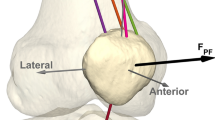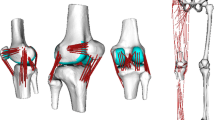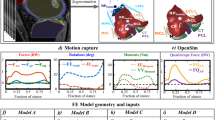Abstract
Musculoskeletal models of the lower extremity make a number of important assumptions when attempting to estimate muscle forces and tibiofemoral compartmental loads in activities such as gait. The knee is commonly idealized as a planar 2D joint in the sagittal plane with no consideration of motions and equilibrium in remaining planes. With muscle forces predicted, the static equilibrium in the frontal plane is then used to estimate compartmental loads neglecting also joint passive resistance and assuming condylar contact centers. We aimed here to comprehensively investigate the effects of such assumptions on predicted results. While simulating gait and using a hybrid lower extremity model that incorporates a detailed validated 3D finite element model of the knee joint, analyses are repeated with out-of-sagittal plane rotations and moment equilibrium equations neglected (2D model) and tibial compartmental forces estimated using equilibrium in the frontal plane while disregarding passive resistance and assuming fixed contact centers (1D model). Large unbalanced out-of-sagittal plane moments reaching peaks of 30 Nm abduction moment and 12 Nm internal moment at 25 % stance period are computed that are overlooked in the 2D model. Consideration of the knee as a planar 2D joint substantially diminishes muscle forces, anterior cruciate ligament force and tibiofemoral contact forces/stresses when compared to the 3D reference model. Total tibiofemoral contact force peaks at 25 % stance at 4.2 BW in the 3D model that drops to 3.0 BW in the 2D model. The location of contact centers on each plateau also noticeably alters (by as much as 5 mm). Tibiofemoral contact forces further change when the location of contact centers on each plateau is fixed. Results highlight the importance of accurate simulation of 3D motions and equilibrium equations as well as passive joint properties and contact centers.







Similar content being viewed by others
References
Adouni M, Shirazi-Adl A, Shirazi R (2012) Computational biodynamics of human knee joint in gait: from muscle forces to cartilage stresses. J Biomech 45:2149–2156
Adouni M, Shirazi-Adl A (2014a) Evaluation of knee joint muscle forces and tissue stresses-strains during gait in severe OA versus normal subjects. J Orthop Res 32:69–78
Adouni M, Shirazi-Adl A (2014b) Partitioning of knee joint internal forces in gait is dictated by the knee adduction angle and not by the knee adduction moment. J Biomech 47:1696–1703
Arnold EM, Ward SR, Lieber RL, Delp SL (2010) A model of the lower limb for analysis of human movement. Ann Biomed Eng 38:269–279
Astephen JL (2007) Biomechanical factors in the progression of Knee osteoarthritis. School of Biomedical Engineering, Dalhousie University, Halifax,
Astephen JL, Deluzio KJ, Caldwell GE, Dunbar MJ (2008) Biomechanical changes at the hip, knee, and ankle joints during gait are associated with knee osteoarthritis severity. J Orthop Res 26:332–341
Bendjaballah MZ, Shirazi-Adl A, Zukor D (1995) Biomechanics of the human knee joint in compression: reconstruction, mesh generation and finite element analysis. Knee 2:69–79
Bendjaballah M, Shirazi-Adl A, Zukor D (1997) Finite element analysis of human knee joint in varus-valgus. Clin Biomech 12:139–148
Blagojevic M, Jinks C, Jeffery A, Jordan K (2010) Risk factors for onset of osteoarthritis of the knee in older adults: a systematic review and meta-analysis. Osteoarthr Cartil 18:24–33
Bull AM, Kessler O, Alam M, Amis AA (2008) Changes in knee kinematics reflect the articular geometry after arthroplasty. Clin Orthop Relat Res 466:2491–2499
de Leva P (1996) Adjustments to Zatsiorsky-Seluyanov’s segment inertia parameters. J Biomech 29:1223–1230
Delp SL et al (2007) OpenSim: open-source software to create and analyze dynamic simulations of movement. IEEE Trans Biomed Eng 54:1940–1950
Delp SL, Loan JP, Hoy MG, Zajac FE, Topp EL, Rosen JM (1990) An interactive graphics-based model of the lower extremity to study orthopaedic surgical procedures. IEEE Trans Biomed Eng 37:757–767
DeMers MS, Pal S, Delp SL (2014) Changes in tibiofemoral forces due to variations in muscle activity during walking. J Orthop Res 32:769–776
Dumas R, Moissenet F, Gasparutto X, Cheze L (2012) Influence of joint models on lower-limb musculo-tendon forces and three-dimensional joint reaction forces during gait. Proc Inst Mech Eng H J Eng Med 226:146–160
Freeman M, Pinskerova V (2005) The movement of the normal tibio-femoral joint. J Biomech 38:197–208
Gerus P et al (2013) Subject-specific knee joint geometry improves predictions of medial tibiofemoral contact forces. J Biomech 46:2778–2786
Glitsch U, Baumann W (1997) The three-dimensional determination of internal loads in the lower extremity. J Biomech 30:1123–1131
Guilak F (2011) Biomechanical factors in osteoarthritis. Best Pract Res Clin Rheumatol 25:815–823
Horsman MK, Koopman H, Veeger H, van der Helm F (2007) The Twente Lower Extremity Model: a comparison of maximal isometric moment with the literature. The Twente Lower Extremity Model:65
Hunt AE, Smith RM, Torode M, Keenan A-M (2001) Inter-segment foot motion and ground reaction forces over the stance phase of walking. Clin Biomech 16:592–600
Katz JN, Earp BE, Gomoll AH (2010) Surgical management of osteoarthritis. Arthritis Care Res 62:1220–1228
Kazemi M, Li L (2014) A viscoelastic poromechanical model of the knee joint in large compression. Med Eng Phys 36:998–1006
Kim HJ, Fernandez JW, Akbarshahi M, Walter JP, Fregly BJ, Pandy MG (2009) Evaluation of predicted knee-joint muscle forces during gait using an instrumented knee implant. J Orthop Res 27:1326–1331
Kim S (2008) Changes in surgical loads and economic burden of hip and knee replacements in the US: 1997–2004. Arthritis Care Res 59:481–488
Kumar D, Rudolph KS, Manal KT (2012) EMG-driven modeling approach to muscle force and joint load estimations: case study in knee osteoarthritis. J Orthop Res 30:377–383
Lerner ZF, Board WJ, Browning RC (2015b) Pediatric obesity and walking duration increase medial tibiofemoral compartment contact forces. J Orthop Res 34:97–105
Lerner ZF, DeMers MS, Delp SL, Browning RC (2015a) How tibiofemoral alignment and contact locations affect predictions of medial and lateral tibiofemoral contact forces. J Biomech 48:644–650
Li G, DeFrate LE, Park SE, Gill TJ, Rubash HE (2005a) In vivo articular cartilage contact kinematics of the knee an investigation using dual-orthogonal fluoroscopy and magnetic resonance image-based computer models. Am J Sports Med 33:102–107
Li G, Pierce JE, Herndon JH (2006) A global optimization method for prediction of muscle forces of human musculoskeletal system. J Biomech 39:522–529
Lloyd DG, Besier TF (2003) An EMG-driven musculoskeletal model to estimate muscle forces and knee joint moments in vivo. J Biomech 36:765–776
Losina E, Thornhill TS, Rome BN, Wright J, Katz JN (2012) The dramatic increase in total knee replacement utilization rates in the United States cannot be fully explained by growth in population size and the obesity epidemic. J Bone Joint Surg Am 94:201–207
Manal K, Buchanan TS (2013) An electromyogram-driven musculoskeletal model of the knee to predict in vivo joint contact forces during normal and novel gait patterns. J Biomech Eng 135:021014
Marouane H, Shirazi-Adl A, Adouni M, Hashemi J (2014) Steeper posterior tibial slope markedly increases ACL force in both active gait and passive knee joint under compression. J Biomech 47:1353–1359
Marouane H, Shirazi-Adl A, Adouni M (2015a) Knee joint passive stiffness and moment in sagittal and frontal planes markedly increase with compression. Comput Methods Biomech Biomed Eng 18:339–350
Marouane H, Shirazi-Adl A, Hashemi J (2015b) Quantification of the role of tibial posterior slope in knee joint mechanics and ACL force in simulated gait. J Biomech 48(10):1899–1905
Marouane H, Shirazi-Adl A, Adouni M (2016) Alterations in knee contact forces and centers in stance phase of gait: a detailed lower extremity musculoskeletal model. J Biomech 49:185–192
Mesfar W, Shirazi-Adl A (2005) Biomechanics of the knee joint in flexion under various quadriceps forces. Knee 12:424–434
Miller RH, Esterson AY, Shim JK (2015) Joint contact forces when minimizing the external knee adduction moment by gait modification: a computer simulation study. Knee 22(6):481–489
Moglo K, Shirazi-Adl A (2003) On the coupling between anterior and posterior cruciate ligaments, and knee joint response under anterior femoral drawer in flexion: a finite element study. Clin Biomech 18:751–759
Mokhtarzadeh H, Perraton L, Fok L, Muñoz MA, Clark R, Pivonka P, Bryant AL (2014) A comparison of optimisation methods and knee joint degrees of freedom on muscle force predictions during single-leg hop landings. J Biomech 47:2863–2868
Mononen ME, Jurvelin JS, Korhonen RK (2015) Implementation of a gait cycle loading into healthy and meniscectomised knee joint models with fibril-reinforced articular cartilage. Comput Methods Biomech Biomed Eng 18:141–152
Pena E, Calvo B, Martinez M, Doblare M (2006) A three-dimensional finite element analysis of the combined behavior of ligaments and menisci in the healthy human knee joint. J Biomech 39:1686–1701
Pierce JE, Li G (2005) Muscle forces predicted using optimization methods are coordinate system dependent. J Biomech 38:695–702
Sandholm A, Schwartz C, Pronost N, de Zee M, Voigt M, Thalmann D (2011) Evaluation of a geometry-based knee joint compared to a planar knee joint. Vis Comput 27:161–171
Sartori M, Reggiani M, Farina D, Lloyd DG (2012) EMG-driven forward-dynamic estimation of muscle force and joint moment about multiple degrees of freedom in the human lower extremity. PloS One 7:e52618
Shelburne KB, Pandy MG (1997) A musculoskeletal model of the knee for evaluating ligament forces during isometric contractions. J Biomech 30:163–176
Shelburne K, Pandy M (1998) Determinants of cruciate-ligament loading during rehabilitation exercise. Clin Biomech 13:403–413
Shelburne KB, Pandy MG (2002) A dynamic model of the knee and lower limb for simulating rising movements. Comput Methods Biomech Biomed Eng 5:149–159
Shelburne KB, Pandy MG, Anderson FC, Torry MR (2004) Pattern of anterior cruciate ligament force in normal walking. J Biomech 37:797–805
Shelburne KB, Torry MR, Pandy MG (2006) Contributions of muscles, ligaments, and the ground-reaction force to tibiofemoral joint loading during normal gait. J Orthop Res 24:1983–1990
Shirazi-Adl A, Moglo K (2005) Effect of changes in cruciate ligaments pretensions on knee joint laxity and ligament forces. Comput Methods Biomech Biomed Eng 8:17–24
Shirazi R, Shirazi-Adl A, Hurtig M (2008) Role of cartilage collagen fibrils networks in knee joint biomechanics under compression. J Biomech 41:3340–3348
Steele KM, DeMers MS, Schwartz MH, Delp SL (2012) Compressive tibiofemoral force during crouch. gait. Gait Posture 35:556–560
Taylor WR, Heller MO, Bergmann G, Duda GN (2004) Tibio-femoral loading during human gait and stair climbing. J Orthop Res 22:625–632
Valente G, Pitto L, Stagni R, Taddei F (2015) Effect of lower-limb joint models on subject-specific musculoskeletal models and simulations of daily motor activities. J Biomech 48:4198–4205
Winby CR, Lloyd DG, Besier TF, Kirk TB (2009) Muscle and external load contribution to knee joint contact loads during normal gait. J Biomech 42:2294–2300
Xiao M, Higginson JS (2008) Muscle function may depend on model selection in forward simulation of normal walking. J Biomech 41:3236–3242
Yang N, Canavan P, Nayeb-Hashemi H, Najafi B, Vaziri A (2010a) Protocol for constructing subject-specific biomechanical models of knee joint. Comput Methods Biomech Biomed Eng 13:589–603
Zander T, Dreischarf M, Schmidt H (2016) Sensitivity analysis of the position of the intervertebral centres of reaction in upright standing-a musculoskeletal model investigation of the lumbar spine. Med Eng Phys 38:297–301
Acknowledgements
The current work was supported by a grant from the Natural Sciences and Engineering Research Council of Canada (RGPIN5596). The partial scholarship of MUTAN-Tunisia to the first author is also acknowledged.
Author information
Authors and Affiliations
Corresponding author
Ethics declarations
Conflict of interest
The authors declare that they have no conflict of interest.
Rights and permissions
About this article
Cite this article
Marouane, H., Shirazi-Adl, A. & Adouni, M. 3D active-passive response of human knee joint in gait is markedly altered when simulated as a planar 2D joint. Biomech Model Mechanobiol 16, 693–703 (2017). https://doi.org/10.1007/s10237-016-0846-6
Received:
Accepted:
Published:
Issue Date:
DOI: https://doi.org/10.1007/s10237-016-0846-6




